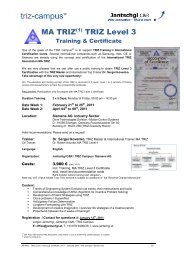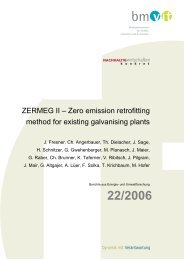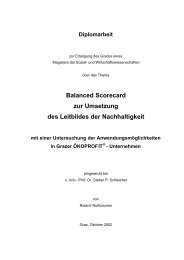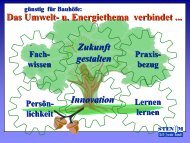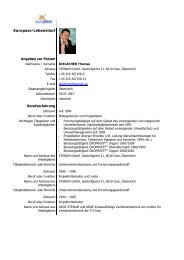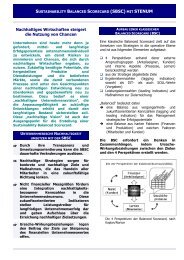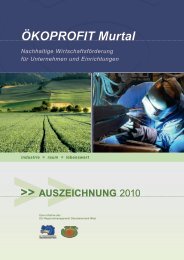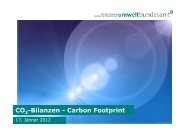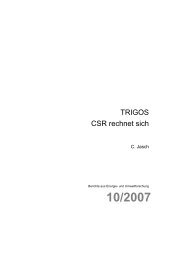Promoting Resource Efficiency in Small & Medium size ... - UNEP
Promoting Resource Efficiency in Small & Medium size ... - UNEP
Promoting Resource Efficiency in Small & Medium size ... - UNEP
You also want an ePaper? Increase the reach of your titles
YUMPU automatically turns print PDFs into web optimized ePapers that Google loves.
• Clean air condition<strong>in</strong>g and refrigeration condenser/evaporator<br />
coils every three months<br />
• Check the refrigerant charge and fix leaks if necessary<br />
• Regularly clean or replace air filters on ventilation and heat<strong>in</strong>g/<br />
air condition<strong>in</strong>g equipment; clean grease traps on ventilation<br />
equipment<br />
• Check freezer and walk-<strong>in</strong> seals for cracks and warp<strong>in</strong>g; replace if<br />
necessary<br />
6.4.6 Production materials<br />
Cool<strong>in</strong>g lubricants 58<br />
The metal work<strong>in</strong>g process creates heat and friction dur<strong>in</strong>g processes<br />
such as cutt<strong>in</strong>g, turn<strong>in</strong>g and gr<strong>in</strong>d<strong>in</strong>g, which limits the tool life.<br />
Conventional coolants are emulsions of oil <strong>in</strong> water (approximately 5<br />
to 7% of oil). Coolants take heat away from the tools and the material<br />
be<strong>in</strong>g processed.<br />
The useful life of coolants is limited by a variety of reasons:<br />
• Coolants break down because the organic molecules decompose<br />
by heat or by the activity of bacteria.<br />
• Coolants accumulate foreign substances <strong>in</strong>clud<strong>in</strong>g tramp oil,<br />
swarf, dissolved m<strong>in</strong>erals, and/or dirt from the process<br />
The follow<strong>in</strong>g h<strong>in</strong>ts will help to <strong>in</strong>crease the useful life of coolants:<br />
• Use de-m<strong>in</strong>eralized water to prepare the coolant. This prevents<br />
the <strong>in</strong>troduction of salts. The m<strong>in</strong>erals present are not evaporated<br />
and accumulate <strong>in</strong> the sump <strong>in</strong>creas<strong>in</strong>g the concentration of<br />
m<strong>in</strong>erals <strong>in</strong> the coolant.<br />
• Anaerobic bacteria grow <strong>in</strong> environments lack<strong>in</strong>g oxygen. They<br />
feed upon the coolant and produce noxious byproducts such as<br />
hydrogen sulphide. This is commonly referred to as the ‘Monday<br />
morn<strong>in</strong>g’ odour. It is possible to prevent the growth of anaerobic<br />
bacteria by agitat<strong>in</strong>g or aerat<strong>in</strong>g the sump over periods of time<br />
when the process is not <strong>in</strong> operation, <strong>in</strong>clud<strong>in</strong>g weekends.<br />
• A process to remove surface oil and solids is also necessary for<br />
long coolant life.<br />
• A variety of filter media, filter<strong>in</strong>g devices and oil skimmers exist<br />
to remove impurities <strong>in</strong>clud<strong>in</strong>g swarf and tramp oil from the<br />
coolant.<br />
• When coolant is changed the sumps should be cleaned<br />
thoroughly.<br />
• Metal swarf and tramp oil may be able to be recycled. Oil may<br />
also be sold as a fuel.<br />
• Separation of cool<strong>in</strong>g lubricants from metal parts can be done<br />
effectively us<strong>in</strong>g centrifuges and vibrat<strong>in</strong>g screens.<br />
Pa<strong>in</strong>t<strong>in</strong>g<br />
The required fluid pressure <strong>in</strong> a conventional spray gun is based on<br />
deliver<strong>in</strong>g a certa<strong>in</strong> amount of pa<strong>in</strong>t through the gun. The best way of<br />
sett<strong>in</strong>g the correct pressure is the follow<strong>in</strong>g: atomis<strong>in</strong>g air is shut off and<br />
the pressure is set <strong>in</strong>itially to about 0.5 pounds per square <strong>in</strong>ch (psi).<br />
The atomis<strong>in</strong>g air is adjusted to zero and the pa<strong>in</strong>t gun is triggered.<br />
When the stream of pa<strong>in</strong>t leav<strong>in</strong>g the gun tip is about 30 cm long, the<br />
fluid pressure sett<strong>in</strong>g is adequate.<br />
Higher pressure will result <strong>in</strong> heavy pa<strong>in</strong>t flow and large particle <strong>size</strong>.<br />
In general, the fluid pressure should not be greater than 1.5 bar. If more<br />
pressure is required, a larger pa<strong>in</strong>t gun tip is probably needed.<br />
It may be necessary to reset the guns and pot pressure several times per<br />
day if the temperature changes. The same is true when new or different<br />
batches of pa<strong>in</strong>t are used.<br />
One way to avoid chang<strong>in</strong>g conditions is to use heat<strong>in</strong>g bands on pa<strong>in</strong>t<br />
pots. Not only will the guns rema<strong>in</strong> set longer, fewer solvents will be<br />
needed for th<strong>in</strong>n<strong>in</strong>g. Heat can be used <strong>in</strong>stead of solvent to provide<br />
pa<strong>in</strong>t th<strong>in</strong>n<strong>in</strong>g with some types of pa<strong>in</strong>t.<br />
Today many pa<strong>in</strong>ts are sold as water-based pa<strong>in</strong>ts. Water-based pa<strong>in</strong>ts<br />
use water <strong>in</strong> place of some or all of the solvent used for th<strong>in</strong>n<strong>in</strong>g and<br />
dispersion. Many water-based pa<strong>in</strong>ts also conta<strong>in</strong> <strong>in</strong>creased content of<br />
solids result<strong>in</strong>g <strong>in</strong> greatly <strong>in</strong>creased coverage. In addition water-based<br />
pa<strong>in</strong>ts are comparable to solvent-based pa<strong>in</strong>ts <strong>in</strong> performance. Some<br />
are as good or better than solvent-based pa<strong>in</strong>ts <strong>in</strong> adhesion, scratch<br />
resistance, abrasion, salt spray resistance and UV resistance.<br />
The skill of the person operat<strong>in</strong>gthe spray gun has a tremendous effect<br />
on transfer efficiency and coverage. Often pa<strong>in</strong>ters have not been<br />
properly tra<strong>in</strong>ed or do not have the correct tools such as measur<strong>in</strong>g<br />
equipment or high efficiency spray equipment. Basic tra<strong>in</strong><strong>in</strong>g for<br />
operators can reduce problems greatly.<br />
• Avoid clear<strong>in</strong>g the gun when pa<strong>in</strong>t<strong>in</strong>g – trigger<strong>in</strong>g the pa<strong>in</strong>t gun<br />
when the gun is po<strong>in</strong>ted at the floor or ceil<strong>in</strong>g or anywhere but<br />
the part be<strong>in</strong>g pa<strong>in</strong>ted wastes pa<strong>in</strong>t.<br />
• Pa<strong>in</strong>t guns should be moved parallel to the surface and not by<br />
mov<strong>in</strong>g the pa<strong>in</strong>t gun <strong>in</strong> an arc which will cause the ends of the<br />
stroke to be too far away and too close <strong>in</strong> the middle.<br />
• Avoid too much or too little overlap; a 50% overlap pattern is<br />
usually recommended to avoid heavy and light areas.<br />
• Avoid thick coat<strong>in</strong>g; the applied thickness should be<br />
checked by measur<strong>in</strong>g and compar<strong>in</strong>g aga<strong>in</strong>st the suppliers<br />
recommendations.<br />
• Avoid us<strong>in</strong>g <strong>in</strong>correct fan pattern; a wide fan pattern is great<br />
for wide open spaces but it is not so good for pa<strong>in</strong>t<strong>in</strong>g narrow<br />
edges, because a narrow edge will occupy only a small portion<br />
of the fan. The rest of the pa<strong>in</strong>t is overspray.<br />
• Avoid <strong>in</strong>creas<strong>in</strong>g the pressure above the recommended<br />
sett<strong>in</strong>g; <strong>in</strong>creas<strong>in</strong>g fluid and atomis<strong>in</strong>g pressure well above<br />
the recommended sett<strong>in</strong>g is common and the result is usually<br />
wasted pa<strong>in</strong>t.<br />
• Avoid hold<strong>in</strong>g the gun at an angle; spray guns should be po<strong>in</strong>ted<br />
perpendicular to a surface as hold<strong>in</strong>g it at an angle results <strong>in</strong> some<br />
or the entire spray pattern be<strong>in</strong>g too far away from the surface.<br />
The pa<strong>in</strong>t booth is important from a worker exposure, quality, and pa<strong>in</strong>t<br />
usage perspective. A pa<strong>in</strong>t booth is <strong>in</strong>tended to collect overspray pa<strong>in</strong>t<br />
and to remove solvent fumes from the work area. If pa<strong>in</strong>t<strong>in</strong>g is done <strong>in</strong><br />
an area with no ventilation, fumes will build, result<strong>in</strong>g <strong>in</strong> a fire and health<br />
hazard. Also, overspray pa<strong>in</strong>t will settle on newly pa<strong>in</strong>ted surfaces caus<strong>in</strong>g<br />
quality problems. Pa<strong>in</strong>t booths also elim<strong>in</strong>ate drafts of air that could carry<br />
pa<strong>in</strong>t away from the workspace and onto neighbour<strong>in</strong>g cars and build<strong>in</strong>gs.<br />
It is important to provide make-up air for the booth. If a booth exhausts<br />
100 m³/m<strong>in</strong>, then an equal amount of air must be brought <strong>in</strong>to the build<strong>in</strong>g<br />
to avoid negative pressure situations. Insufficient make-up air will result<br />
<strong>in</strong> reduced flow through the booth elim<strong>in</strong>at<strong>in</strong>g the booth’s benefits.<br />
Use a wash<strong>in</strong>g mach<strong>in</strong>e to clean guns.<br />
58) http://www.p2pays.org/ref/01/00072.htm<br />
62



